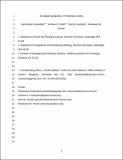| dc.contributor.author | Chakrabarti, Ramananda | |
| dc.contributor.author | Knoll, Andrew Herbert | |
| dc.contributor.author | Jacobsen, Stein B. | |
| dc.contributor.author | Fischer, Woodward W. | |
| dc.date.accessioned | 2013-07-08T16:13:18Z | |
| dc.date.issued | 2012 | |
| dc.identifier.citation | Chakrabarti, Ramananda, Andrew Herbert Knoll, Stein B. Jacobsen, and Woodward W. Fischer. 2012. Si isotopic variability of Proterozoic cherts. Geochimica et Cosmochimica Acta 91:187-201. | en_US |
| dc.identifier.issn | 0016-7037 | en_US |
| dc.identifier.uri | http://nrs.harvard.edu/urn-3:HUL.InstRepos:10860682 | |
| dc.description.abstract | We report Si-isotopic compositions of 75 sedimentologically and petrographically characterized chert samples with ages ranging from ~2600 to 750 Ma using multi-collector inductively coupled plasma mass spectrometry. \(\delta^{30}\)Si values of the cherts analyzed in this study show a ~7‰ range, from −4.29 to +2.85. This variability can be explained in part by (1) simple mixing of silica derived from continental (higher \(\delta^{30}\)Si) and hydrothermal (lower \(\delta^{30}\)Si) sources, (2) multiple mechanisms of silica precipitation and (3) Rayleigh-type fractionations within pore waters of individual basins. We observe ~3‰ variation in peritidal cherts from a single Neoproterozoic sedimentary basin (Spitsbergen). This variation can be explained by Rayleigh-type fractionation during precipitation from silica-saturated porewaters. In some samples, post-dissolution and reprecipitation of silica could have added to this effect. Our data also indicate that peritidal cherts are enriched in the heavier isotopes of Si whereas basinal cherts associated with banded iron formations (BIF) show lower \(\delta^{30}\)Si. This difference could partly be due to Si being derived from hydrothermal sources in BIFs. We postulate that the difference in \(\delta^{30}\)Si between non-BIF and BIF cherts is consistent with the contrasting genesis of these deposits. Low \(\delta^{30}\)Si in BIF is consistent with laboratory experiments showing that silica adsorbed onto Fe-hydroxide particles preferentially incorporates lighter Si isotopes. Despite large intrabasinal variation and environmental differences, the data show a clear pattern of secular variation. Low \(\delta^{30}\)Si in Archean cherts is consistent with a dominantly hydrothermal source of silica to the oceans at that time. The monotonically increasing \(\delta^{30}\)Si from 3.8 to 1.5 Ga appears to reflect a general increase in continental versus hydrothermal sources of Si in seawater, as well as the preferential removal of lighter Si isotopes during silica precipitation in iron-associated cherts from silica-saturated seawater. The highest \(\delta^{30}\)Si values are observed in 1.5 Ga peritidal cherts; in part, these enriched values could reflect increasing sequestration of light silica during soil-forming processes, thus, delivering relatively heavy dissolved silica to the oceans from continental sources. The causes behind the reversal in trend towards lower \(\delta^{30}\)Si in cherts younger than 1.5 Ga old are less clear. Cherts deposited 1800–1900 Ma are especially low \(\delta^{30}\)Si, a possible indication of transiently strong hydrothermal input at this time. | en_US |
| dc.description.sponsorship | Earth and Planetary Sciences | en_US |
| dc.description.sponsorship | Organismic and Evolutionary Biology | en_US |
| dc.language.iso | en_US | en_US |
| dc.publisher | Meteoritical Society | en_US |
| dc.relation.isversionof | doi:10.1016/j.gca.2012.05.025 | en_US |
| dash.license | OAP | |
| dc.title | Si Isotope Variability in Proterozoic Cherts | en_US |
| dc.type | Journal Article | en_US |
| dc.description.version | Accepted Manuscript | en_US |
| dc.relation.journal | Geochimica et Cosmochimica Acta | en_US |
| dash.depositing.author | Knoll, Andrew Herbert | |
| dc.date.available | 2013-07-08T16:13:18Z | |
| dc.identifier.doi | 10.1016/j.gca.2012.05.025 | * |
| dash.contributor.affiliated | Chakrabarti, Ramananda | |
| dash.contributor.affiliated | Knoll, Andrew | |
| dash.contributor.affiliated | Jacobsen, Stein | |


